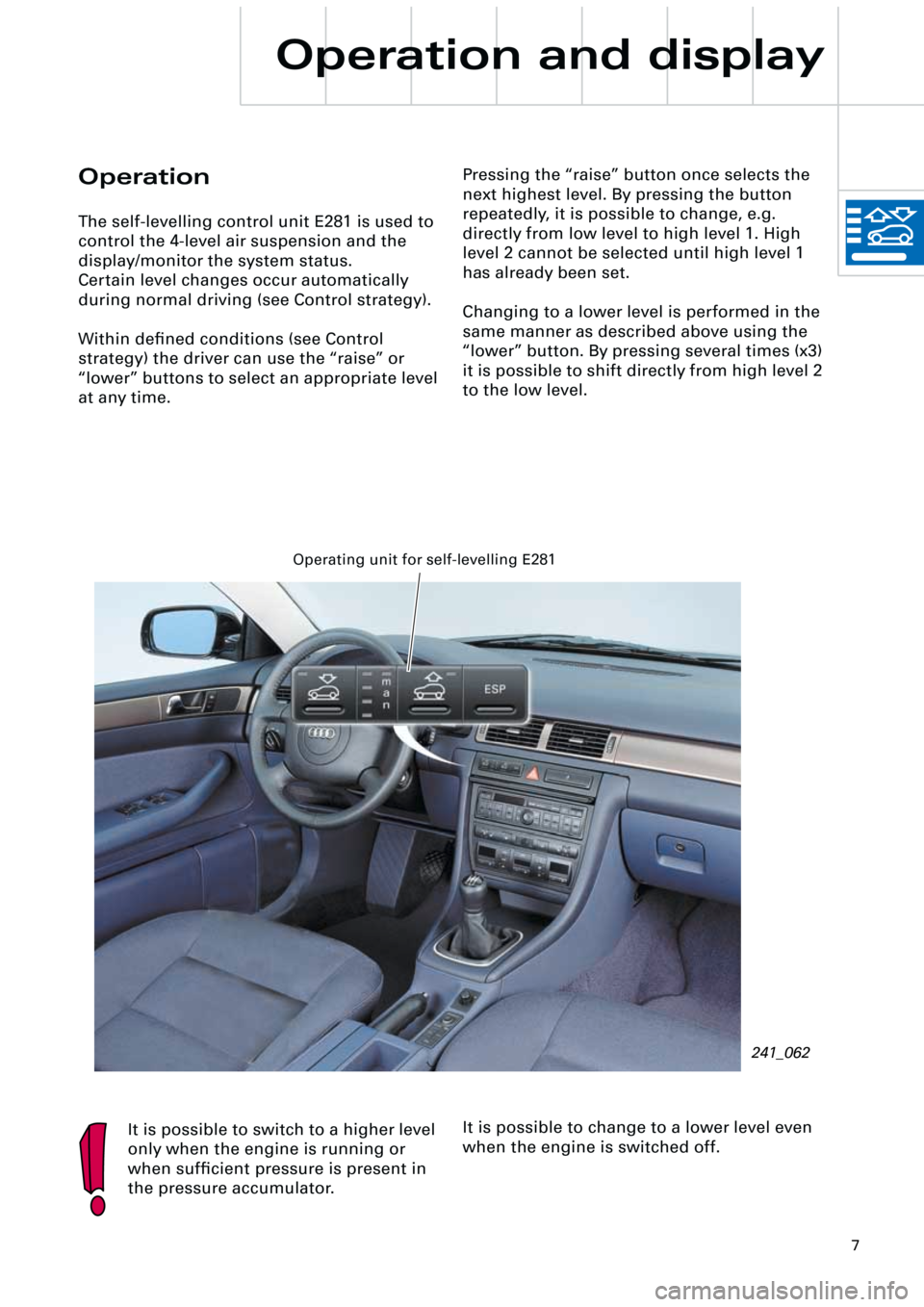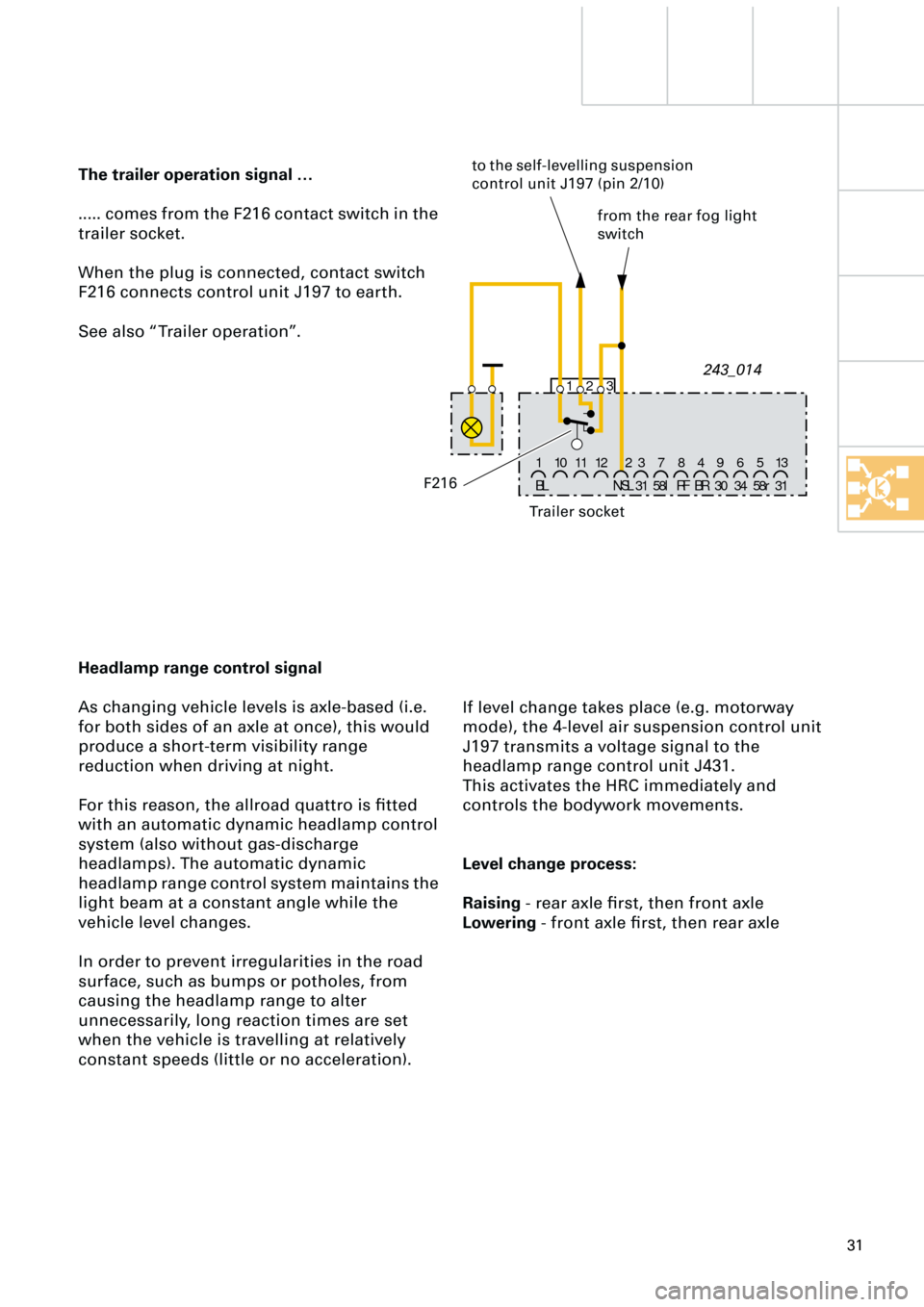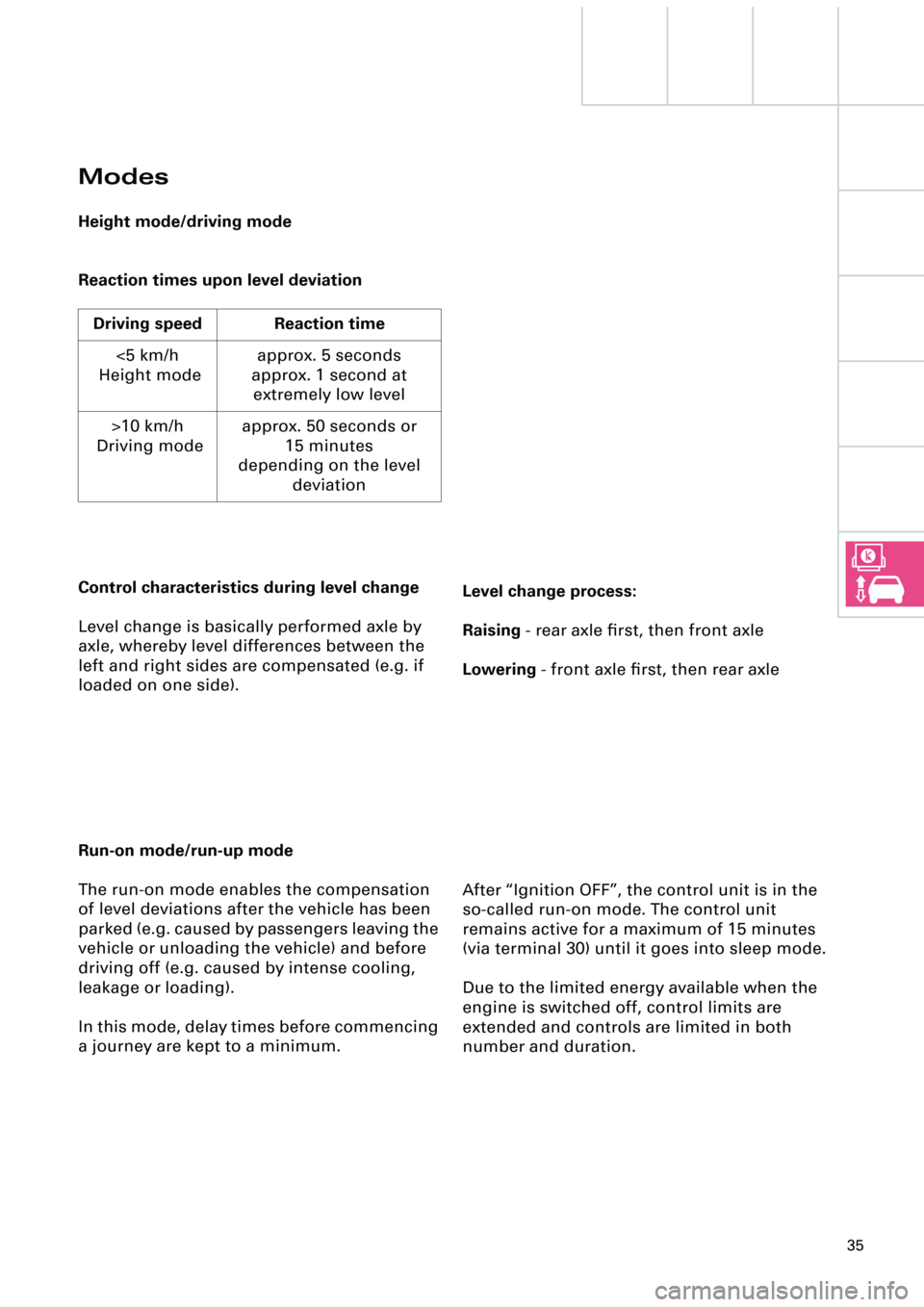change time AUDI A6 ALLROAD 1999 C5 / 2.G Pneumatic Suspension System
[x] Cancel search | Manufacturer: AUDI, Model Year: 1999, Model line: A6 ALLROAD, Model: AUDI A6 ALLROAD 1999 C5 / 2.GPages: 44, PDF Size: 2.47 MB
Page 7 of 44

7
Operation and display
Operation
The self-levelling control unit E281 is used to
control the 4-level air suspension and the
display/monitor the system status.
Certain level changes occur automatically
during normal driving (see Control strategy).
Within defined conditions (see Control
strategy) the driver can use the “raise” or
“lower” buttons to select an appropriate level
at any time. Pressing the “raise” button once selects the
next highest level. By pressing the button
repeatedly, it is possible to change, e.g.
directly from low level to high level 1. High
level 2 cannot be selected until high level 1
has already been set.
Changing to a lower level is performed in the
same manner as described above using the
“lower” button. By pressing several times (x3)
it is possible to shift directly from high level 2
to the low level.
Operating unit for self-levelling E281
241_062
It is possible to switch to a higher level
only when the engine is running or
when sufficient pressure is present in
the pressure accumulator.
It is possible to change to a lower level even
when the engine is switched off.
Page 27 of 44

27
Warning lamp K134...
... illuminates for one second when
terminal 15 is ON (self-test).
... is constantly illuminated in the
case of relevant system errors or
when the system is switched off.
... is constantly illuminated during
basic system setting and when
basic system setting has not been
performed successfully.
... flashes in the case of extremely
low or high levels.
... flashes during final control
diagnosis.
242_050 Warning lamp K134
As no magnetic materials are required,
temperature and age cause only minimal
variances in the measured values. Such
variances are caused by a reduction in the
strength of the magnetic field of permanent
magnets over time or due to temperature
changes. Level sensors, summary
The advantages of the angle sensor are the
proportional measurement process along
with their contact-free and therefore wear-
free operation.
The generation of ratios (proportional
measurement) means that the output signal
proportional to the angle is largely
independent of mechanical tolerances such
as distance changes, axle movement or
inclination errors. Magnetic interference is
also largely suppressed due to the generation
of ratios.
Page 31 of 44

31
123
1 237 8496513
BL NSL 31 58l RF BR 30 34 58r 3110 11 12
The trailer operation signal …
..... comes from the F216 contact switch in the
trailer socket.
When the plug is connected, contact switch
F216 connects control unit J197 to earth.
See also “Trailer operation”.
Headlamp range control signal
As changing vehicle levels is axle-based (i.e.
for both sides of an axle at once), this would
produce a short-term visibility range
reduction when driving at night.
For this reason, the allroad quattro is fitted
with an automatic dynamic headlamp control
system (also without gas-discharge
headlamps). The automatic dynamic
headlamp range control system maintains the
light beam at a constant angle while the
vehicle level changes.
In order to prevent irregularities in the road
surface, such as bumps or potholes, from
causing the headlamp range to alter
unnecessarily, long reaction times are set
when the vehicle is travelling at relatively
constant speeds (little or no acceleration). If level change takes place (e.g. motorway
mode), the 4-level air suspension control unit
J197 transmits a voltage signal to the
headlamp range control unit J431.
This activates the HRC immediately and
controls the bodywork movements.
Level change process:
Raising - rear axle first, then front axle
Lowering - front axle first, then rear axle
243_014
Trailer socket to the self-levelling suspension
control unit J197 (pin 2/10)
from the rear fog light
switch
F216
Page 35 of 44

35
Level change process:
Raising - rear axle first, then front axle
Lowering - front axle first, then rear axle
Modes
Height mode/driving mode
Reaction times upon level deviation
Control characteristics during level change
Level change is basically performed axle by
axle, whereby level differences between the
left and right sides are compensated (e.g. if
loaded on one side).Driving speed Reaction time
<5 km/h
Height modeapprox. 5 seconds
approx. 1 second at
extremely low level
>10 km/h
Driving modeapprox. 50 seconds or
15 minutes
depending on the level
deviation
Run-on mode/run-up mode
The run-on mode enables the compensation
of level deviations after the vehicle has been
parked (e.g. caused by passengers leaving the
vehicle or unloading the vehicle) and before
driving off (e.g. caused by intense cooling,
leakage or loading).
In this mode, delay times before commencing
a journey are kept to a minimum.After “Ignition OFF”, the control unit is in the
so-called run-on mode. The control unit
remains active for a maximum of 15 minutes
(via terminal 30) until it goes into sleep mode.
Due to the limited energy available when the
engine is switched off, control limits are
extended and controls are limited in both
number and duration.